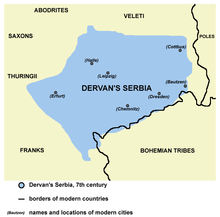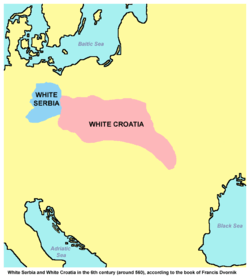White Serbia
White Serbia (Serbian: Бела Србија/Bela Srbija), called Boiki (rendered in Serbian as Bojka), is the mythical homeland of the ancestors of the Serbs, the White Serbs (Beli Srbi). Boiki is mentioned in De Administrando Imperio, a 10th-century work by Byzantine Emperor Constantine VII (r. 913–959)
The area adjacent to White Serbia was known as White Croatia, where the Croats trace their origin. White Serbia and its ethnic designates, the White Serbs, could be interpreted through attributes such as "the unbaptized" or "pagan" (Pre-Christian), according to the DAI.
Location
Theories on the location of White Serbia has been disputed. It has been described by historians as:
- Slovak historian P. J. Šafárik (1795–1865) classified the White Serbs as a Polabian Slavonic tribe.[1][2]
- Austro-Hungarian B. Kállay (1839–1903) noted that many historians assumed that White Serbia was identical to the Czech lands (Bohemia), or that the Czech lands were part of White Serbia, based on DAI's account and the name Bojka.[3] He however believed that Šafařík's theory was more likely; that White Serbia was north of the Carpathians, stretching over western Russia and eastern Poland.[3]
- Yugoslav historian V. Ćorović (1885–1941) believed White Serbia included Galicia and the area around the sources of Dniester and Vistula.[4]
- Yugoslav human geographer B. Drobnjaković (1890–1961) noted that Bojka reminded of Bohemia.[5]
- Greek historian A. Stratos (1905–1981) believed it to be Bohemia.[6]
- Yugoslav Serbian historian S. Ćirković (1929–2009) believed it to be between the Elbe and Saale rivers.[7]
- Serbian historian L. Cerović (b. 1936) connected it to the land of the Boykos, Bojkovina, in the northern Carpathians.[8]
- Historian F. Conte (b. 1944) believed it to be in the area of Poland.[9]
- Serbian historian R. Novaković (1911–2003) connected the name to Bohemia (in turn derived from Celtic Boii) and located it in Polabia.[10]
- The area of Red Ruthenia (now western Ukraine) or the island of Rügen.[11]
- Lusatia, a triangle formed by parts of Germany, the Czech Republic and Poland.
- J. Kovaćević noted the toponym Beloserbye in a 1393 document, situated in Poland between Czarnków and Żnin.[12]
-

Dervan's polity in the 7th century.
-

Samo's realm in 631, including Dervan's polity.
-

White Serbia and White Croatia (around 560), according to Francis Dvornik.
-

Lusatian (Sorb) theory.
-

Dual Proto-Serb migration theory (Sorbs and Serbs).
-

Lusatian (Sorb) theory, including Proto-Slav lands.
See also
References
- ↑ H.H. Howorth Esq. FSA The Spread of Slaves Part III, P 181 "They are classed together by Schafarik under the name of Polabian Slaves"
- ↑
- 1 2 Béni Kállay (1882). Istorija srpskoga naroda. Petar Curčić. p. 14.
- ↑ Ćorović 2001, ch. Словени насељавају Балкан.
- ↑ Borivoje M. Drobnjaković (1960). Etnologija naroda Jugoslavije. 1 (1960). Naučna knjiga. p. 102.
- ↑ Andreas Nikolaou Stratos (1968). Byzantium in the seventh century. Adolf M. Hakkert.
- ↑ Ćirković, Sima (7 June 2004). The Serbs. Wiley. p. 17. ISBN 978-0-631-20471-8.
- ↑ Ljubivoje Cerović (2002). Srbi u Ukrajini. Muzej Vojvodine. p. 13.
- ↑ Francis Conte (1995). The Slavs. East European Monographs. p. 28. ISBN 978-0-88033-310-8.
- ↑ Vizantološki institut (1996). Recueil de travaux de l'Institut des études byzantines. 35. Vizantološki institut SANU. p. 127.
- ↑ The Journal of the Anthropological institute. 1879.
- ↑ Zbornik radova Vizantološkog instituta. 38. Institut. 2000. p. 91.
Sources
- Constantine VII Porphyrogenitus (1993). De Administrando Imperio (Moravcsik, Gyula ed.). Washington D.C.: Dumbarton Oaks Center for Byzantine Studies.
- Einhard. Annales regni Francorum [Royal Frankish Annals] (in Latin).
- Ćorović, Vladimir (2001). Istorija srpskog naroda (Internet ed.). Belgrade: Ars Libri.
- Fine, John Van Antwerp (1991). The Early Medieval Balkans: A Critical Survey from the Sixth to the Late Twelfth Century. Michigan: The University of Michigan Press. ISBN 0-472-08149-7.
- Ferjančić, Božidar (1959). Vizantiski izvori za istoriju naroda Jugoslavije. 2. Vizantološki institut SANU. pp. 5, 47.
- Летопис Матице српске. 141–144. У Српској народној задружној штампарији. 1885. p. 145.
- Viktor Novak (1973). Istoriski časopis. 20. Prosveta. p. 7.
- The South Slav Journal. 22–23. Dositey Obradovich Circle. 2001. p. 149.
- Zbigniew Gołąb (1992). The origins of the Slavs: a linguist's view. Slavica Publishers, Inc. p. 397. ISBN 978-0-89357-224-2.
Further reading
- Sakač, Simeon (1994). "Бојки — прапостојбина Срба на Карпатима". Рад музеја Војводине. 36: 145–149. (Serbian)
- Novaković, Relja (1977). Odakle su Srbi došli na Balkansko poluostrvo. Istorijski institut. (Serbian)
- Županić, Niko (1922). "Bela Srbija". Narodna starina. Zagreb. 2: 107–118. (Croatian)